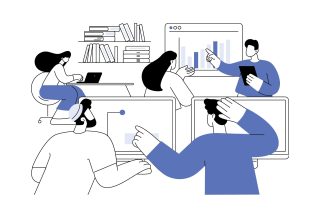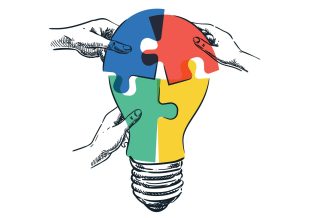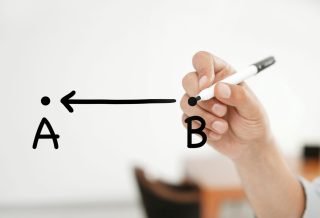FOCUS
How do I know my students are learning?
By Amy Burton
Categories: Continuous improvement, Fundamentals, Implementation, Learning designs, PersonalizationApril 2020
Vol 41, No. 2
Why is formative assessment — a proven powerful instructional practice — so elusive in classrooms?
As a regional professional learning provider for several years, I regularly observed classroom practice to collect data on how to best support my teachers. I rarely observed the use of formative assessment, even though, when asked, teachers could define it — a quick check, during instruction, of what all students understand so far about the learning objective.
When I did observe formative assessment, the most common practice was a simple “thumbs up if you understand.” But teachers didn’t check the truth or accuracy of these perceptions.
A few more advanced teachers used white boards on which students could display responses, such as their answers to math problems. Yet teachers seldom used that information to inform their practices. Regardless of understanding, teachers continued to teach the lesson as planned.
The lack of formative assessment was apparent among both veteran and novice teachers, even though novice teachers’ recent university coursework included assessment for learning. So why wasn’t formative assessment an established practice, particularly with the newly trained teachers?
To pursue the mystery of why formative assessment was so highly recommended but not practiced, I led an action research cohort as part of my dissertation research. I explored how teachers participating in a reflective learning community shifted their mental models of teaching and learning as a result of using formative assessment to inform implementation of professional learning for long-term change.
Action research project
I conducted the action research project under the umbrella of a districtwide professional learning initiative funded by a federal Race to the Top grant to the state of Nevada. For that grant, 10 implementation specialists and I sought to shift secondary teachers’ instructional practices from a teaching-centered to a learning-centered stance. Guiding me in this research were Bill Thornton and Janet Usinger of the University of Nevada, Reno educational leadership department.
The grant defined a learning-centered teacher as one whose main focus is on continual assessment of students’ learning. Student learning was defined as progress toward identified learning targets that are created collectively by teachers and based on the required state or federal standards. As Blumberg (2016) explained, “Learning-centered teaching shifts the focus of instruction from what the teacher does to how and how well the students learn” (p. 303).
Within the district-directed professional learning requirements funded by the grant, I gained permission to study the relationship between a learning-centered stance and my cohort of middle school science teachers’ current teaching practices, including whether and how they used formative assessment.
Four out of 14 middle school science teachers volunteered to explore their beliefs and assumptions about teaching and learning for this project. With this group, I led the development of our own action research learning community, which we named the reflective learning team.
I created a plan/observe/debrief protocol to support the data collection and analysis process and analyzed team members’ lesson planning, instruction, and student learning data through a lesson study cycle that repeated weekly over a two-year period.
Participants studied their lessons with me in the role of coach, individually through journal reflections, and with their fellow learning team participants. This process was grounded in Learning Forward’s Standards for Professional Learning (see table below).
Build teachers’ practice
While conducting preassessments with the teachers, I noted a lack of formative assessment practice. Because formative assessment is central to the definition of learning-centered practice, I intentionally aimed to build teachers’ use of this practice.
I designed a learning experience that would model the use of formative assessment and support teachers’ metacognition so that they would be better prepared to use formative assessment with their students.
We began by establishing learning targets. As we continued working together, I checked for evidence of understanding and progress toward the participants’ learning targets by qualitative analysis of their plan/observe/debrief data and coaching sessions, the minutes from their group lesson study sessions, and their individual journal reflections on their learning process. I shared my analysis of individual teachers’ practice during coaching sessions and my analysis of the team’s progress as a whole during lesson study meetings.
We worked together to assess and reflect on student outcomes, based on district curriculum targets for science that had been developed the year before, in alignment with the Next Generation Science Standards.
During our data analysis, we searched for evidence of students’ progress toward understanding the science content and meeting these new learning targets, as well as how teachers’ shifts in instructional practice affected students’ progress. Throughout this process, we discussed the use of formative assessment and engaged in metacognition.
Shifting practice
Participants implemented formative assessment methods to check for students’ understanding, and all reported that it shifted their teaching, acting as a gate that opened their minds to what learning-centered instruction encompassed.
One way participants began to measure learning was with preassessments. Their former practice was to sort through activities that aligned with the learning target and assume they knew which ones students needed. Instead, participants preassessed their students and planned based on the resulting data.
One participant summarized the learning-centered assessment shift in this way: “Observe first, formatively assess, and then guide learners to their educational goals.” Participants also described repurposing former practices as formative assessments. Those practices included warm-ups, predictions, exit tickets, and science journal reflections.
This process shifted teachers’ understanding of who is responsible for learning and how. For example, one participant described how her new assessment mindset changed her interactions with students from a focus on classroom management to facilitating learning: “I am changing the way I speak. Instead of coming around and saying, ‘Get moving,’ I switched to, ‘Do you understand?’ And if they said no, I asked what they were thinking. I clarified their understanding of the instructions. It surprised me, when you throw it back out to them, and ask, ‘What are you thinking?’
Another participant realized the need to be present with students and reflect with them: “My hardest shift is that I’m very focused on the destination, and this process is not about the destination. … Now I see that I need to monitor more as my students go on the journey I have set for them. … If my focus is just the test, the final destination, then I miss a lot. … I’m having an aha moment: Right now, we measure our students’ actions along the way, not their learning.”
Once participants understood the value of formative assessment, they realized they now had to respond to the varied student needs the data revealed. Not all students were learning at the same pace or in the same way. Teachers began experimenting with differentiated instruction, an instructional practice that had eluded them in the past. It was at this point in the participants’ learning progression that our two-year research project ended.
Learning-centered instruction
The teacher participants identified formative assessment as key to their understanding and valuing of the many elements of learning-centered instruction. This understanding evolved through a three-step, domino-like process:
Understand the importance of learning targets in their instructional practice.
Recognize the need to develop students’ higher-order thinking skills.
Acknowledge the need to partner with students rather than being the expert.
Learning targets. In the past, participants said, their use of learning targets was a compliance-level activity based on observation protocol requirements. They came to realize they would need to change their practices based on the new Next Generation Science Standards-aligned learning targets.
One participant described a major shift in her lesson planning, explaining that “having such a focused learning target has led me to really think about the value of each lesson, or even the value of each activity. I continually ask myself if what I am doing will get the students to where they need to be to master the concept.”
Another teacher said that when she began engaging in ongoing formative assessment aligned with the target and the unit common assessment, her students “did equal to or better than the other teachers’. I was blown away by how well my students did on that [common] assessment.” Formative assessment allowed her to not only move students’ understanding forward but also collect evidence of her instructional impact on student learning.
Higher-order thinking skills. Once participants committed to planning lessons based on the learning targets and formative assessment of student understanding, they discovered that the Next Generation Science Standards required an increase in student higher-order thinking skills that their previous lessons had not emphasized.
In addition, the common summative assessments they had designed to measure mastery of the learning targets now required students to model, describe, and explain scientific phenomena. Higher-order thinking skills could not be measured by the multiple choice tests they had previously employed, so their formative assessments needed to focus on what students were thinking.
The benefit was immediately identified: “We aren’t teaching to a test. We are teaching to a skill.” One participant summarized the shift this way: “I’m measuring their ability to think.” Another talked about the value of “letting kids run with higher-order thinking questions and inquiry.” As a result, one participant noted, “The engagement went up and the [mis] behavior went down.”
And when formative assessment showed that students did not progress as expected, participants re-evaluated alignment of their instruction with their targets, noted a need for higher-order thinking skills, and made a change that led to increased student engagement in the learning.
This process helped them identify challengesin supporting higher-order thinking. One explained, “During the teaching part, I need to focus more on helping the students work harder and with purpose in their own learning.”
Teacher and student learning partnership. The search for ways to support higher-order thinking skills among students led to the third domino, the teachers’ recognition that they were no longer the experts imparting knowledge to students. To develop students’ higher-order thinking skills, participants had to partner with them. This challenged their assumptions about their roles as teachers and their students’ capacity as learners.
The participants explored how to facilitate learning rather than deliver content. One participant described her rethinking of roles and relationships: “One of the things I’ve had to learn to let go of is the need to have control of everything. I need to focus on what’s important. … It frees me up to help students needing help and allows them to take control of their learning.”
Another participant said: “I came to gradually realize that my traditional approach wasn’t always challenging my students or allowing them to show me just what they understood. … I thought practicing the information using a variety of techniques created a learning community. I had to confront myself and realize that just because I delivered the curriculum didn’t mean that the students were using their own resources and initiative to understand the content.”
Participants noted that formative assessment shifted the teacher-student talk ratio. They observed that when they talked less and listened to students more, they gained real-time insights into student progress toward mastery of the learning targets. In addition, they were able to identify students’ misconceptions, which better focused their lessons. One participant explained the connection between formative assessment and student metacognition this way: “Me knowing what students know is not new, but me helping the students see what they know is new.”
Benefits for all learners
By modeling learning-centered instruction, formative assessment tied to learning objectives, metacognition, and differentiation, the reflective learning team process gave teachers the chance to experience what formative assessment looked, felt, and sounded like.
They concluded that it supported their learning. They experimented with it in their classrooms, and their students came to the same conclusion. Participants recognized this connection. As one said, “Learning-centered isn’t just about the students learning. It’s about us learning, too.”
After only one year, this team of accomplished veteran teachers had come to understand what had evaded them for years of traditional, teacher-centered instruction: Teaching and assessing are not separate. They should constantly work as one.
A brief history of formative assessment
Formative assessment is not novel, but neither is it well-established. Formative assessment was not part of my experience as a K-12 public school student growing up in the United States. It was not part of my curriculum when I was a teacher candidate entering the profession in 1980. Nor was it a featured subject when I earned my master’s degree in 1991.
However, as the standards movement gained momentum during the 1980s, formative assessment began to creep into my professional development experiences and classroom observation checklists. Black and Wiliam published Inside the Black Box: Raising Standards Through Classroom Assessment, their landmark study of the impact of formative assessment on learning, in 1998.
By 2005, when I applied for National Board Certification, formative assessment was foundational to that process. Nevertheless, I still struggled as a high school teacher to use assessment to inform my instruction because the data the district collected were not easily accessible to classroom teachers. I had to pioneer my own student learning data with little support.
Then, in 2013, formative assessment became part of our state teacher evaluation standards. Teachers were now required to support student metacognition by communicating learning targets, assisting students in analyzing their progress toward those targets based on ongoing formative assessment, and differentiate instruction based on the resulting student learning data. Yet I saw many teachers continuing to struggle with its use, and this drove my interest in conducting this study.
How the learning team applied the Standards for Professional Learning
Learning Communities: The reflective learning team, a cohort of teachers, conducted the action research project. Throughout, team members shared goals, data, and reflections with one another and me. The reflective learning team, a cohort of teachers, conducted the action research project. Throughout, team members shared goals, data, and reflections with one another and me.
Leadership: Through my doctoral program, I assumed and fully committed to the role of primary leader, supported by program mentors and district permission.
Resources: Funds from a Race to the Top grant and the structures and financial and human capital of my doctoral program supported the project.
Data: Together, team members and I reviewed their lesson planning, instruction, and student learning data through a lesson study cycle. I created a plan/observe/debrief protocol to support the data collection and analysis process.
Learning Designs: We built the effort to build teachers’ knowledge about formative assessment on principles of adult development, including research on change management, teacher efficacy and leadership, and modeling the skills teachers are expected to use with students.
Implementation: We conducted the project in an ongoing, continuous manner, with the learning building on itself over time. The team planned for sustaining these practices beyond the period of the project.
Outcomes: Throughout, the focus was on improving student understanding and mastery through building teachers’ capacity to check for understanding and make necessary changes in instruction.
References
GBlack, P. & Wiliam, D. (1998). Inside the black box: Raising standards through classroom assessment. Phi Delta Kappa, 80(2), 139-148.
Blumberg, P. (2016). Factors that influence faculty adoption of learning-centered approaches. Innovative Higher Education, 41, 303-315.
Categories: Continuous improvement, Fundamentals, Implementation, Learning designs, Personalization
Recent Issues
BUILDING BRIDGES
December 2024
Students benefit when educators bridge the continuum of professional...
CURRICULUM-BASED PROFESSIONAL LEARNING
October 2024
High-quality curriculum requires skilled educators to put it into...
LEARNING TO PIVOT
August 2024
Sometimes new information and situations call for major change. This issue...
GLOBAL PERSPECTIVES
June 2024
What does professional learning look like around the world? This issue...












